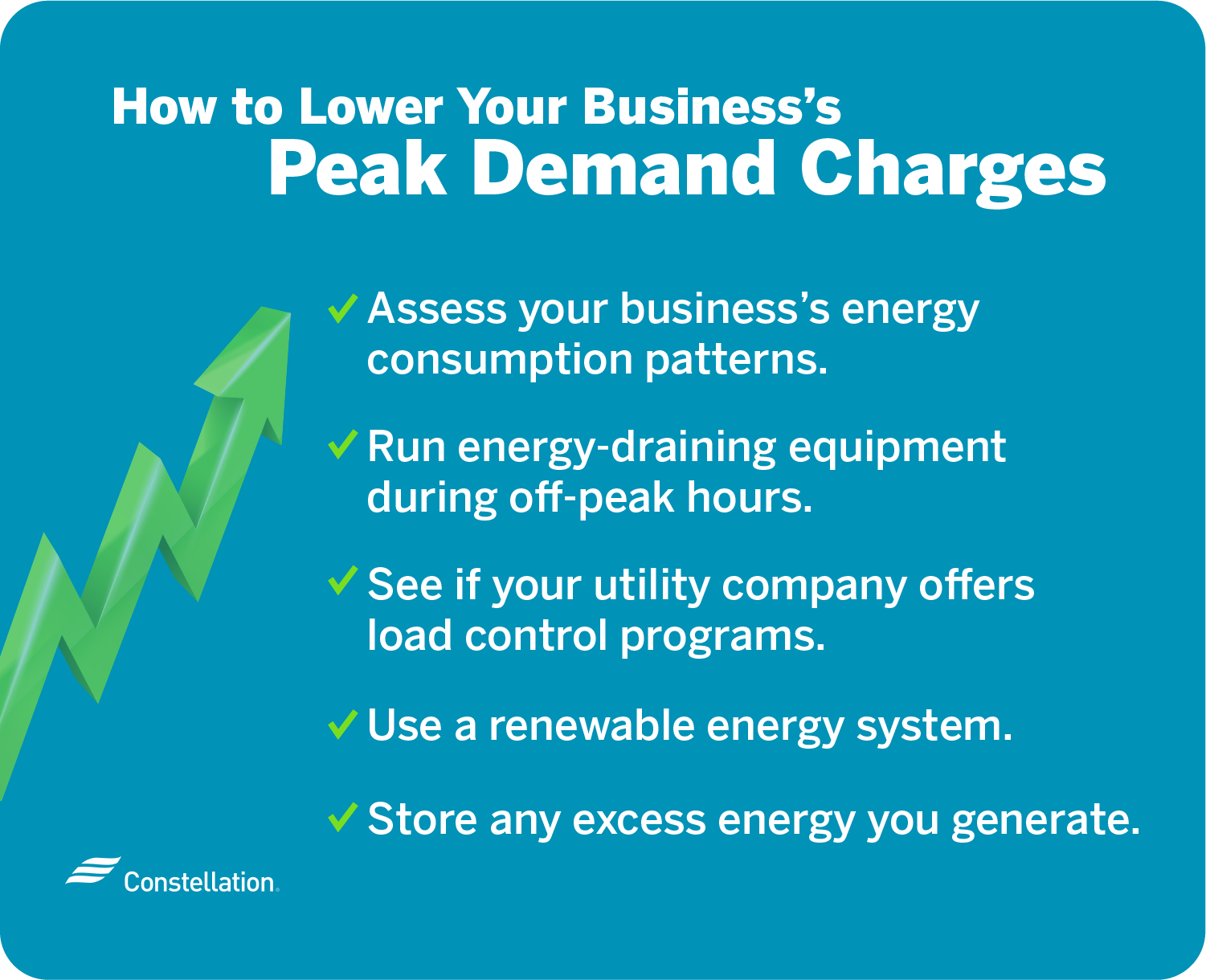
- Category:
Small Business Energy Savings -
Last updated:
March 17, 2022
How to Reduce Your Small Business’s Peak Demand Charges
When you get your electric bill for your small business, you’ll see two big charges: one for demand and one for consumption. When you understand what each of these are, you can make small changes in how you’re using electricity in your business that can bring down your overall bill.
- Consumption measures the electricity consumed in kilowatt-hours (kWh) per each billing cycle. That’s energy used over time. Think of it as the total number of miles you travel from point A to point B.
- Demand measures the rate at which you’re using energy in kilowatts (kW) at a given time, often in 15-minute intervals. Think of it as the speed at which you travel from point A to point B.
What is peak load pricing for electricity?
Peak load rates are key to understanding your small-business energy pricing. You get charged for demand because power companies have to reliably provide you with power even in spurts when you’re consuming it very fast. Those intervals of time are called “peak load” periods. To meet your business’s demand for peak load, the power company must invest in capacity over and above what they need for normal consumption.
That peak load power is expensive. Peak load pricing for businesses encourages you to look for ways to smooth out your demand so that you can reduce pricey peak demand charges in your business.
The effect of peak pricing on your business’s energy costs

When your energy use rate is highly variable throughout the day, the week and the month, you’ll rack up high peak load demand charges that are much higher than the cost of regular power consumption. Peak load pricing is how you end up paying for capacity costs that ensure there’s enough power on demand when you need it.
These charges are highest when your peak demand occurs at the same time that other businesses and residential customers are also using electricity at a fast rate. For example, in the summer, electricity customers tend to use power at a faster rate to run air conditioners on hot afternoons. When it comes to small-business energy consumption, you pay the most during these time periods.
5 Ways to Lower Your Business’s Peak Demand Charges
Now that we have peak demand charges explained, you may be wondering how to reduce those costs. Here are some tips about how time-of-use rates work and how to avoid peak load pricing for your electricity.

1. Assess your business’s energy consumption patterns.
Study the patterns in how much energy your small business uses. Reducing peak demand charges means smoothing out how much electricity you draw across time. The first step in figuring out how to reduce demand charges is to look for times when usage spikes in your business. What equipment is operating and what activities are being done?
2. Run energy-draining equipment during off-peak hours.
You can make a big dent in reducing peak demand charges if you can change your consumption patterns to operate power-hungry equipment and appliances when electricity rates are the lowest.
Maybe it’s possible to use your most energy-draining equipment during off-peak hours. You may be able to start shifts early and end by noon, or run the business at night. Consider reducing your use of air conditioning at peak hours, looking for ways to keep cool air in and hot air out during this time. Think of other draws of electricity that don’t have to run during the day, like the dishwasher in the lunchroom. The little things can add up.
3. See if your utility company offers load control programs.
Load control programs take the guesswork out of managing when energy-draining equipment should run at less-expensive times. When you enroll in this program, the power company installs cycling devices on certain equipment so that they can be powered down for short periods of time. It may, for example, periodically turn off your air conditioner.
In most cases, the automated cycling is hardly noticeable to you or your staff. But it can make a big difference in controlling and reducing peak demand charges.
4. Use a renewable energy system.
If you have the opportunity to use renewable energy to supplement what your business draws from the grid, you can turn to these alternatives during peak use times. Your business can purchase renewable energy systems that turn sun, wind or hydropower into electricity. Because you rely less on your power utility, you can reduce peak demand charges. In some cases, you can enjoy a tax benefit, too.
5. Store any excess energy you generate.
Renewable energy isn’t always dependable on demand. Your solar panels and windmills only produce power when the sun is shining or the wind is blowing. To make sure you have energy when you need it, you can store it.
The most common storage method is the battery. More exotic options, like flywheels, are not always practical for small businesses. Batteries store power for when it’s needed, which is ideal when you want to manage your demand on the power grid during peak times.
Keeping your business’s energy bill in check
With peak demand charges explained, you can use the knowledge to your advantage. Understanding small-business energy pricing is the first step to reducing peak demand charges that can send your energy bills through the roof.
Managing when you operate power-hungry equipment to make time-of-use rates work in your favor can pay off. And taking advantage of energy company programs gives you even more options for lowering your small business’s energy bill.




